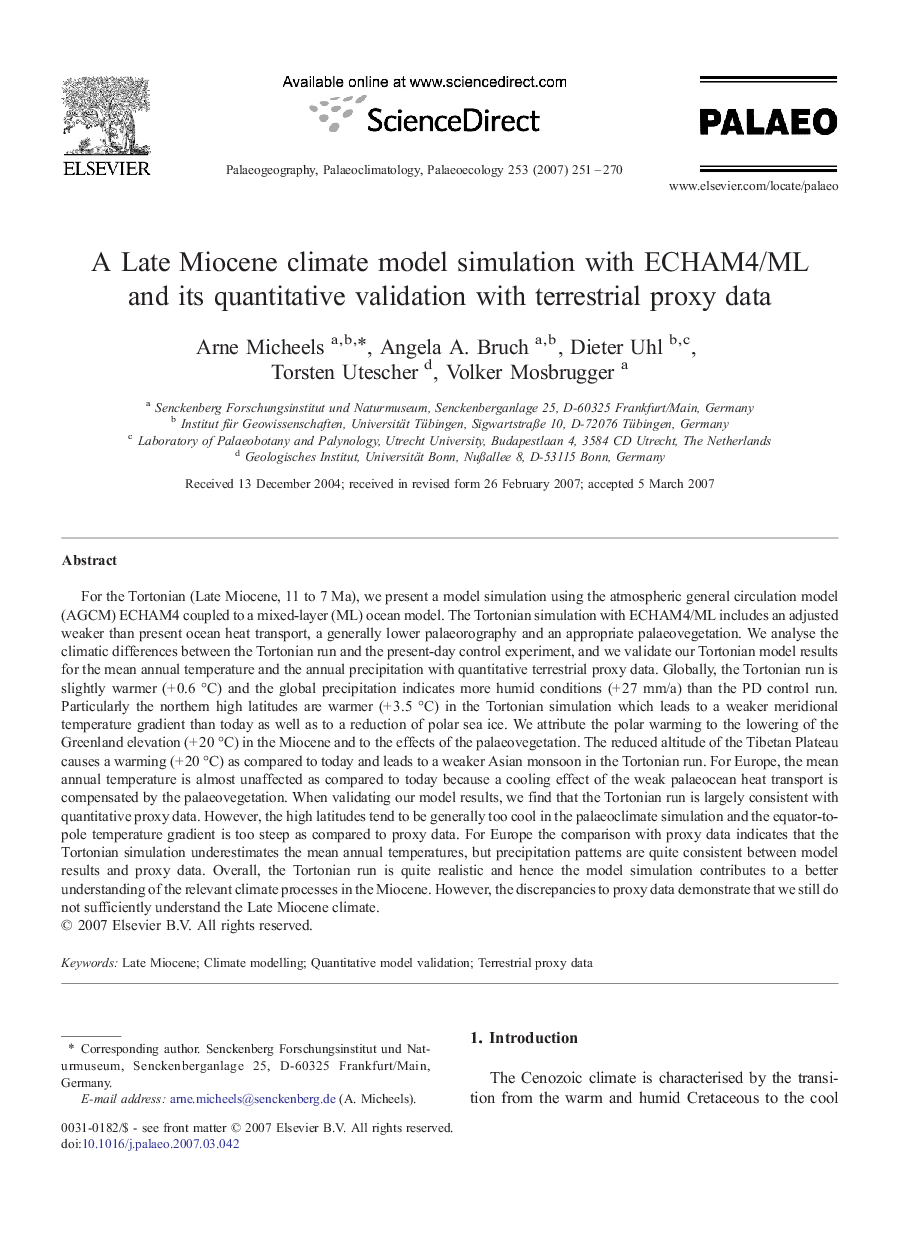| کد مقاله | کد نشریه | سال انتشار | مقاله انگلیسی | نسخه تمام متن |
|---|---|---|---|---|
| 6350760 | 1622345 | 2007 | 20 صفحه PDF | دانلود رایگان |
عنوان انگلیسی مقاله ISI
A Late Miocene climate model simulation with ECHAM4/ML and its quantitative validation with terrestrial proxy data
دانلود مقاله + سفارش ترجمه
دانلود مقاله ISI انگلیسی
رایگان برای ایرانیان
موضوعات مرتبط
مهندسی و علوم پایه
علوم زمین و سیارات
فرآیندهای سطح زمین
پیش نمایش صفحه اول مقاله

چکیده انگلیسی
For the Tortonian (Late Miocene, 11 to 7 Ma), we present a model simulation using the atmospheric general circulation model (AGCM) ECHAM4 coupled to a mixed-layer (ML) ocean model. The Tortonian simulation with ECHAM4/ML includes an adjusted weaker than present ocean heat transport, a generally lower palaeorography and an appropriate palaeovegetation. We analyse the climatic differences between the Tortonian run and the present-day control experiment, and we validate our Tortonian model results for the mean annual temperature and the annual precipitation with quantitative terrestrial proxy data. Globally, the Tortonian run is slightly warmer (+ 0.6 °C) and the global precipitation indicates more humid conditions (+ 27 mm/a) than the PD control run. Particularly the northern high latitudes are warmer (+ 3.5 °C) in the Tortonian simulation which leads to a weaker meridional temperature gradient than today as well as to a reduction of polar sea ice. We attribute the polar warming to the lowering of the Greenland elevation (+ 20 °C) in the Miocene and to the effects of the palaeovegetation. The reduced altitude of the Tibetan Plateau causes a warming (+ 20 °C) as compared to today and leads to a weaker Asian monsoon in the Tortonian run. For Europe, the mean annual temperature is almost unaffected as compared to today because a cooling effect of the weak palaeocean heat transport is compensated by the palaeovegetation. When validating our model results, we find that the Tortonian run is largely consistent with quantitative proxy data. However, the high latitudes tend to be generally too cool in the palaeoclimate simulation and the equator-to-pole temperature gradient is too steep as compared to proxy data. For Europe the comparison with proxy data indicates that the Tortonian simulation underestimates the mean annual temperatures, but precipitation patterns are quite consistent between model results and proxy data. Overall, the Tortonian run is quite realistic and hence the model simulation contributes to a better understanding of the relevant climate processes in the Miocene. However, the discrepancies to proxy data demonstrate that we still do not sufficiently understand the Late Miocene climate.
ناشر
Database: Elsevier - ScienceDirect (ساینس دایرکت)
Journal: Palaeogeography, Palaeoclimatology, Palaeoecology - Volume 253, Issues 1â2, 14 September 2007, Pages 251-270
Journal: Palaeogeography, Palaeoclimatology, Palaeoecology - Volume 253, Issues 1â2, 14 September 2007, Pages 251-270
نویسندگان
Arne Micheels, Angela A. Bruch, Dieter Uhl, Torsten Utescher, Volker Mosbrugger,